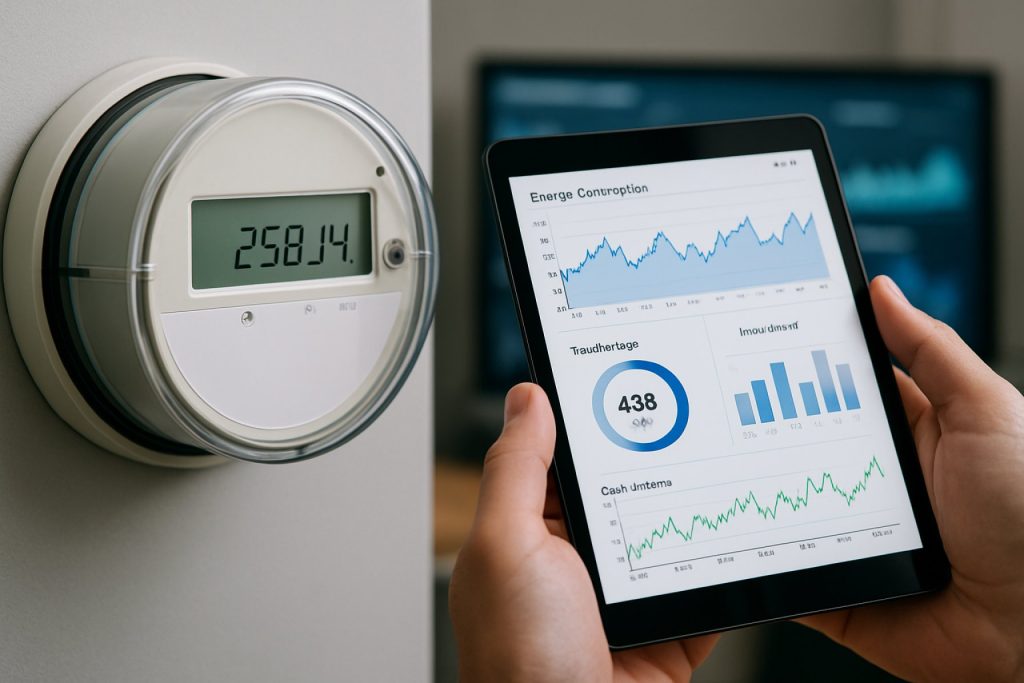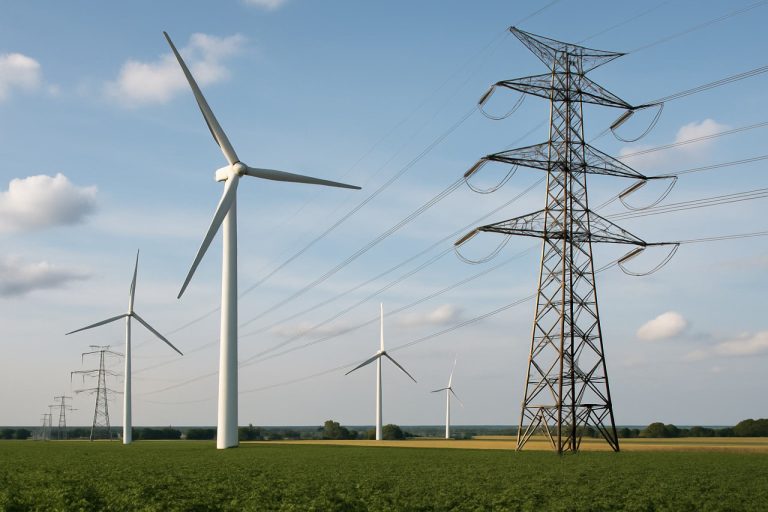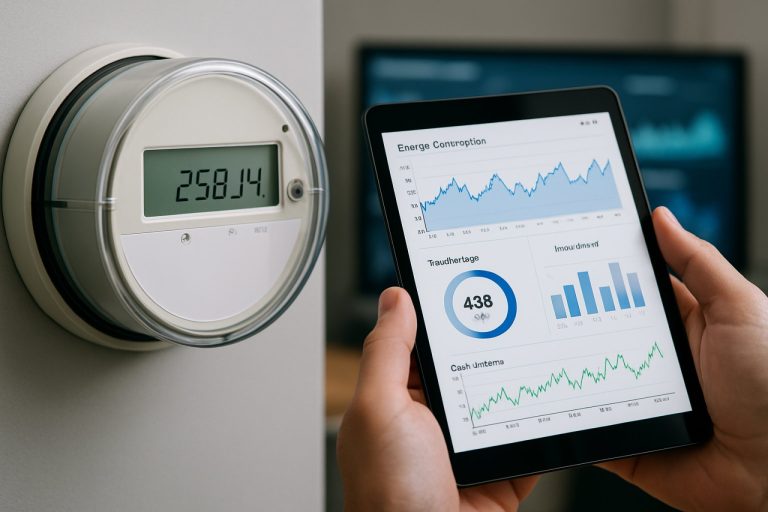
Smart Metering & Energy Usage Analytics in 2025: How Data Intelligence is Revolutionizing Utilities and Empowering Consumers. Explore the Next Wave of Growth, Innovation, and Sustainability in the Energy Sector.
- Executive Summary: Key Trends and Market Outlook (2025–2030)
- Market Size, Growth Rate, and Forecasts: Global and Regional Perspectives
- Technology Landscape: Next-Gen Smart Meters and Advanced Analytics Platforms
- Key Industry Players and Strategic Initiatives (e.g., siemens.com, landisgyr.com, ieee.org)
- Regulatory Drivers and Policy Frameworks Shaping Adoption
- Integration with Renewable Energy and Grid Modernization
- Data Security, Privacy, and Interoperability Challenges
- Emerging Business Models and Value-Added Services
- Case Studies: Real-World Deployments and Measured Impact
- Future Outlook: Innovation Roadmap and Market Opportunities Through 2030
- Sources & References
Executive Summary: Key Trends and Market Outlook (2025–2030)
The global smart metering and energy usage analytics sector is entering a pivotal phase between 2025 and 2030, driven by accelerating digitalization, regulatory mandates, and the urgent need for grid modernization. Utilities worldwide are scaling up deployments of advanced metering infrastructure (AMI), with a focus on real-time data collection, two-way communication, and integration with distributed energy resources (DERs). This transformation is underpinned by the proliferation of smart meters, which are expected to surpass 2 billion units globally by 2030, according to industry projections from leading manufacturers and utility associations.
Key players such as Landis+Gyr, Itron, and Siemens are at the forefront, delivering next-generation metering solutions that enable granular consumption monitoring, remote management, and predictive analytics. These companies are investing heavily in IoT-enabled devices and cloud-based analytics platforms, allowing utilities and end-users to optimize energy usage, detect anomalies, and support demand response programs. For example, Landis+Gyr has expanded its Gridstream® portfolio to include advanced analytics and edge intelligence, while Itron is integrating distributed intelligence into its OpenWay® Riva platform to enhance grid reliability and customer engagement.
Regulatory frameworks in North America, Europe, and Asia-Pacific are mandating smart meter rollouts and data-driven energy management. The European Union’s Clean Energy Package and the U.S. Department of Energy’s grid modernization initiatives are accelerating adoption, with utilities such as Enel and EDF leading large-scale deployments. In Asia, countries like China and India are rapidly expanding their smart metering infrastructure to address grid losses and support renewable integration, with state-owned enterprises and global suppliers collaborating on nationwide projects.
Looking ahead, the convergence of smart metering with artificial intelligence, machine learning, and edge computing will unlock new value streams. Utilities are expected to leverage advanced analytics for predictive maintenance, outage management, and personalized energy services. The sector will also see increased interoperability with home energy management systems and electric vehicle charging infrastructure, further enhancing grid flexibility and consumer empowerment.
Overall, the 2025–2030 outlook for smart metering and energy usage analytics is robust, with sustained investment, technological innovation, and policy support driving widespread adoption and transforming the way energy is measured, managed, and consumed.
Market Size, Growth Rate, and Forecasts: Global and Regional Perspectives
The global market for smart metering and energy usage analytics is experiencing robust growth, driven by accelerating digitalization in the utilities sector, regulatory mandates for grid modernization, and the increasing need for real-time energy management. As of 2025, the installed base of smart electricity meters worldwide is estimated to surpass 1.2 billion units, with particularly high penetration in regions such as Europe, North America, and East Asia. The European Union’s ongoing rollout, underpinned by directives for advanced metering infrastructure (AMI), continues to be a major growth engine, with countries like Italy, France, and the UK nearing or achieving near-universal deployment of smart meters. In North America, utilities such as Itron and Landis+Gyr are leading large-scale deployments, while in Asia-Pacific, China’s State Grid Corporation and Japan’s TEPCO have already installed hundreds of millions of smart meters, with further expansion planned.
The market’s compound annual growth rate (CAGR) for smart metering is projected to remain in the high single digits through 2028, with energy usage analytics solutions outpacing hardware growth as utilities and commercial customers seek to extract actionable insights from granular consumption data. The integration of advanced analytics platforms—offered by companies such as Siemens, Schneider Electric, and Honeywell—is enabling utilities to optimize grid operations, detect anomalies, and support demand response programs. These platforms leverage artificial intelligence and machine learning to forecast demand, identify inefficiencies, and facilitate dynamic pricing models.
Regionally, Europe is expected to maintain its leadership in smart metering penetration, with ongoing second-generation meter upgrades and a growing focus on interoperability and cybersecurity. North America’s market is characterized by a mix of replacement cycles and new deployments, particularly in states with ambitious decarbonization targets. In Asia-Pacific, rapid urbanization and government-led initiatives are driving new installations, with India and Southeast Asian nations emerging as high-growth markets.
Looking ahead, the convergence of smart metering with distributed energy resources (DERs), electric vehicle (EV) integration, and home energy management systems is anticipated to further expand the addressable market. Utilities are increasingly partnering with technology providers to deliver value-added services, such as real-time usage alerts and personalized energy efficiency recommendations, to end-users. As regulatory frameworks evolve and grid modernization accelerates, the global smart metering and energy analytics market is poised for sustained expansion through the remainder of the decade.
Technology Landscape: Next-Gen Smart Meters and Advanced Analytics Platforms
The technology landscape for smart metering and energy usage analytics is rapidly evolving in 2025, driven by the convergence of advanced metering infrastructure (AMI), edge computing, and artificial intelligence (AI). Utilities and technology providers are deploying next-generation smart meters that go beyond basic consumption measurement, enabling real-time data collection, granular load profiling, and two-way communication between consumers and the grid.
Leading manufacturers such as Landis+Gyr, Itron, and Siemens are rolling out smart meters equipped with enhanced connectivity (including NB-IoT, LTE-M, and 5G), improved cybersecurity features, and integrated edge analytics capabilities. These meters can process and transmit high-frequency data, supporting applications like dynamic pricing, demand response, and outage detection. For example, Landis+Gyr’s latest E360 platform offers modular communication and edge intelligence, while Itron’s OpenWay Riva meters leverage distributed intelligence to enable real-time grid management.
On the analytics front, utilities are increasingly adopting cloud-based platforms and AI-driven tools to extract actionable insights from the vast volumes of data generated by smart meters. Companies such as Siemens and Schneider Electric provide advanced analytics suites that enable utilities to forecast demand, detect anomalies, and optimize grid operations. These platforms often integrate with distributed energy resources (DERs), electric vehicle (EV) charging infrastructure, and home energy management systems, supporting the transition to more flexible and resilient energy systems.
A notable trend in 2025 is the growing emphasis on interoperability and open standards. Organizations like the Zigbee Alliance and DLMS User Association are promoting standardized communication protocols, ensuring that smart meters and analytics platforms from different vendors can seamlessly exchange data. This is crucial for large-scale rollouts and for integrating new services as the energy ecosystem becomes more decentralized.
Looking ahead, the next few years are expected to see accelerated deployment of smart meters in emerging markets, increased integration of AI for predictive analytics, and a stronger focus on consumer engagement through real-time feedback and personalized energy insights. As regulatory frameworks evolve and grid modernization initiatives expand, the role of smart metering and advanced analytics will be central to achieving energy efficiency, reliability, and sustainability goals worldwide.
Key Industry Players and Strategic Initiatives (e.g., siemens.com, landisgyr.com, ieee.org)
The smart metering and energy usage analytics sector in 2025 is characterized by rapid technological advancements, strategic partnerships, and a focus on grid modernization. Key industry players are leveraging their expertise to drive innovation, expand global reach, and address evolving regulatory and sustainability demands.
Siemens AG remains a pivotal force in the smart metering landscape, offering integrated solutions that combine advanced metering infrastructure (AMI) with robust analytics platforms. Siemens’ initiatives focus on enabling utilities to optimize grid operations, reduce losses, and empower consumers with real-time energy insights. Their recent collaborations with utility providers in Europe and North America underscore a commitment to digitalizing energy networks and supporting the transition to renewable energy sources. Siemens’ grid software and IoT-enabled meters are central to these efforts, facilitating predictive maintenance and demand response programs (Siemens AG).
Another major player, Landis+Gyr Group AG, continues to expand its global footprint through strategic partnerships and product innovation. Landis+Gyr’s portfolio includes smart electricity, gas, and water meters, as well as advanced data management and analytics solutions. In 2025, the company is actively deploying next-generation meters with enhanced cybersecurity features and interoperability standards, supporting large-scale rollouts in Asia-Pacific and the Americas. Their Gridstream® platform exemplifies the integration of real-time data analytics, enabling utilities to improve outage management and customer engagement (Landis+Gyr Group AG).
Itron, Inc. is also at the forefront, focusing on scalable AMI solutions and cloud-based analytics. Itron’s OpenWay® Riva platform, for example, supports distributed intelligence and edge computing, allowing utilities to process data locally and respond swiftly to grid events. In 2025, Itron is prioritizing partnerships with municipalities and energy retailers to accelerate smart city initiatives and distributed energy resource (DER) integration (Itron, Inc.).
Industry bodies such as the IEEE play a crucial role in standardization and knowledge dissemination. The IEEE’s working groups are actively developing protocols for secure data exchange, interoperability, and advanced metering communications, which are essential for the sector’s continued growth and resilience (IEEE).
Looking ahead, the sector is expected to see increased investment in artificial intelligence-driven analytics, edge computing, and enhanced cybersecurity. Strategic initiatives by leading companies will likely focus on supporting decarbonization, grid flexibility, and consumer empowerment, positioning smart metering and energy analytics as foundational elements of the future energy ecosystem.
Regulatory Drivers and Policy Frameworks Shaping Adoption
The adoption of smart metering and energy usage analytics is being significantly shaped by evolving regulatory drivers and policy frameworks across major global markets in 2025. Governments and regulatory bodies are increasingly mandating the deployment of advanced metering infrastructure (AMI) to support energy transition goals, grid modernization, and consumer empowerment.
In the European Union, the rollout of smart meters is underpinned by the Electricity Directive (EU) 2019/944, which requires member states to ensure that at least 80% of consumers are equipped with smart meters by 2025, provided that a positive cost-benefit assessment is achieved. This directive is part of the broader Clean Energy for All Europeans package, which aims to enhance energy efficiency, integrate renewables, and enable dynamic pricing. National regulators, such as Enedis in France and E.ON in Germany, are actively overseeing large-scale smart meter deployments, with millions of devices already installed and analytics platforms being integrated to provide real-time consumption data to both utilities and end-users.
In the United Kingdom, the government’s Smart Metering Implementation Programme (SMIP) continues to drive the replacement of traditional meters with smart devices. The Department for Energy Security and Net Zero has set ambitious targets for near-universal coverage by 2025, with energy suppliers such as Centrica and EDF Energy responsible for the rollout. Regulatory oversight by Ofgem ensures that data privacy, interoperability, and consumer engagement are prioritized, while the Data Communications Company (DCC) manages the secure transmission of metering data.
In the United States, policy frameworks vary by state but are increasingly aligned with federal incentives for grid modernization and decarbonization. The Infrastructure Investment and Jobs Act (IIJA) and Inflation Reduction Act (IRA) provide funding and tax credits for utilities investing in AMI and advanced analytics. Utilities such as Duke Energy and Southern California Edison are expanding their smart meter fleets and leveraging analytics to support demand response, outage management, and distributed energy resource integration.
Looking ahead, regulatory focus is expected to intensify on interoperability standards, cybersecurity, and the use of granular consumption data to enable dynamic tariffs and personalized energy services. Industry bodies such as ZVEI (Germany) and Smart Energy GB (UK) are actively collaborating with policymakers to refine frameworks that balance innovation, consumer protection, and market competition. As a result, the next few years will likely see accelerated adoption of smart metering and analytics, driven by both compliance requirements and the pursuit of smarter, more resilient energy systems.
Integration with Renewable Energy and Grid Modernization
The integration of smart metering and advanced energy usage analytics is playing a pivotal role in the modernization of electricity grids and the effective incorporation of renewable energy sources. As of 2025, utilities and grid operators are accelerating the deployment of smart meters to enable real-time monitoring, dynamic pricing, and more granular control over distributed energy resources (DERs) such as solar panels, wind turbines, and battery storage systems.
Leading manufacturers and technology providers, including Landis+Gyr, Siemens, and Itron, are at the forefront of supplying advanced metering infrastructure (AMI) that supports two-way communication between consumers and utilities. These systems not only record detailed consumption data but also facilitate demand response programs and grid balancing, which are essential for integrating variable renewable energy sources.
In 2025, the adoption of smart meters is reaching critical mass in several regions. For example, the European Union’s Clean Energy Package has set ambitious targets for smart meter rollouts, with countries like France, Spain, and Italy nearing full deployment. Utilities such as Enel and EDF are leveraging this infrastructure to offer consumers real-time feedback on energy usage, personalized tariffs, and incentives for shifting consumption to periods of high renewable generation.
In North America, utilities including Duke Energy and Southern California Edison are expanding their smart meter fleets and integrating advanced analytics platforms. These platforms, often powered by artificial intelligence and machine learning, enable utilities to forecast demand, detect outages, and optimize the dispatch of renewables and storage assets. The data generated by smart meters is also being used to support grid-edge innovations, such as virtual power plants and peer-to-peer energy trading.
Looking ahead, the next few years will see further convergence between smart metering, energy analytics, and grid modernization initiatives. The proliferation of electric vehicles, heat pumps, and distributed solar will increase the complexity of grid management, making real-time data and analytics indispensable. Industry leaders are investing in interoperable standards and cybersecurity measures to ensure the resilience and scalability of these systems. As a result, smart metering and analytics are set to become foundational technologies for a flexible, decarbonized, and consumer-centric energy ecosystem.
Data Security, Privacy, and Interoperability Challenges
The rapid deployment of smart metering and advanced energy usage analytics is transforming the energy sector, but it also brings significant challenges in data security, privacy, and interoperability—issues that are expected to intensify through 2025 and beyond. As utilities and grid operators increasingly rely on real-time data from millions of smart meters, the volume and sensitivity of information being collected and transmitted have grown exponentially. This data includes granular consumption patterns, which, if improperly secured, could reveal personal habits or even occupancy status, raising substantial privacy concerns.
In 2025, regulatory frameworks such as the European Union’s General Data Protection Regulation (GDPR) and the U.S. Department of Energy’s guidelines continue to shape how utilities handle consumer data. Utilities and technology providers are investing in robust encryption, secure communication protocols, and advanced authentication mechanisms to protect data both in transit and at rest. For example, Landis+Gyr, a global leader in smart metering solutions, emphasizes end-to-end encryption and regular security audits as part of its product offerings. Similarly, Siemens integrates cybersecurity features into its smart grid infrastructure, focusing on secure device onboarding and continuous monitoring to detect anomalies.
Interoperability remains a persistent challenge as utilities deploy devices from multiple vendors, each with proprietary communication protocols and data formats. Industry alliances such as the Zigbee Alliance and Open Metering System Group are working to standardize protocols, enabling seamless integration and data exchange across heterogeneous systems. The adoption of open standards like DLMS/COSEM and the push for device certification are expected to accelerate through 2025, reducing vendor lock-in and fostering a more competitive ecosystem.
Despite these advances, the sector faces ongoing risks from increasingly sophisticated cyber threats. In 2024, several utilities reported attempted breaches targeting smart meter networks, underscoring the need for continuous investment in cybersecurity. Companies such as Itron and Schneider Electric are expanding their cybersecurity services, offering utilities managed security solutions and real-time threat intelligence tailored to smart grid environments.
Looking ahead, the convergence of smart metering, IoT, and cloud-based analytics will require even greater attention to data governance, privacy-by-design principles, and cross-industry collaboration. As regulatory scrutiny intensifies and the threat landscape evolves, utilities and technology providers must prioritize secure, interoperable solutions to maintain consumer trust and ensure the resilience of critical energy infrastructure.
Emerging Business Models and Value-Added Services
The rapid deployment of smart metering infrastructure is catalyzing a wave of new business models and value-added services in the energy sector, particularly as utilities and technology providers leverage granular consumption data for both operational efficiency and customer engagement. As of 2025, the global installed base of smart electricity meters is projected to surpass 1.5 billion units, with significant momentum in Europe, North America, and Asia-Pacific. This proliferation is driven by regulatory mandates, decarbonization goals, and the need for real-time grid management.
Utilities such as Enel and EDF are at the forefront, rolling out advanced metering infrastructure (AMI) that enables two-way communication and near real-time data collection. These capabilities underpin a shift from traditional commodity sales to service-oriented models. For example, time-of-use pricing, demand response programs, and personalized energy insights are now being offered to residential and commercial customers, incentivizing load shifting and energy conservation.
Technology providers like Landis+Gyr and Siemens are expanding their platforms to include analytics suites that process high-frequency meter data. These platforms enable utilities to detect anomalies, forecast demand, and optimize distributed energy resources (DERs) such as rooftop solar and battery storage. In parallel, companies such as Itron are integrating artificial intelligence and machine learning to deliver predictive maintenance and outage management services, reducing operational costs and improving reliability.
A notable trend is the emergence of third-party energy management services targeting both consumers and businesses. Firms like Schneider Electric are leveraging smart meter data to offer energy-as-a-service (EaaS) models, where customers pay for outcomes such as reduced consumption or carbon footprint rather than kilowatt-hours. These models are expected to gain traction as corporate sustainability commitments intensify and as regulatory frameworks evolve to support data sharing and interoperability.
Looking ahead, the next few years will likely see further integration of smart metering with home automation, electric vehicle charging, and peer-to-peer energy trading platforms. The European Union’s Clean Energy Package and similar initiatives in other regions are expected to accelerate this convergence by mandating greater consumer access to real-time data and fostering competitive retail markets. As a result, the value chain is expanding beyond traditional utilities to include technology vendors, aggregators, and new market entrants, all vying to monetize the growing pool of energy usage analytics.
Case Studies: Real-World Deployments and Measured Impact
The deployment of smart metering and advanced energy usage analytics has accelerated globally, with 2025 marking a period of significant expansion and measurable impact. Utilities and governments are leveraging these technologies to enhance grid reliability, empower consumers, and support decarbonization goals.
One of the most prominent case studies is the nationwide rollout of smart meters in the United Kingdom. By early 2025, over 30 million smart meters have been installed in homes and small businesses, enabling near real-time energy consumption data and two-way communication between consumers and energy suppliers. This initiative, led by EDF Energy and other major utilities, has resulted in a measurable reduction in energy consumption, with the UK government reporting average household savings of 2-3% and improved load balancing across the grid. The data collected is also being used to inform demand response programs and support the integration of renewable energy sources.
In the United States, Duke Energy has expanded its smart meter deployment to over 8 million customers across several states. The company’s advanced analytics platform processes billions of data points daily, providing customers with detailed usage insights and personalized energy-saving recommendations. Duke Energy reports that customers who actively engage with their usage data reduce their energy consumption by up to 5%. Additionally, the utility has leveraged smart meter data to detect outages more rapidly and optimize grid maintenance, resulting in improved service reliability.
On the European continent, Enel has been a pioneer in smart metering, with its Italian subsidiary completing the installation of second-generation smart meters for over 32 million customers. These meters support advanced analytics, enabling dynamic pricing and automated demand response. Enel’s data shows that dynamic tariffs, made possible by granular consumption data, have shifted peak demand by up to 10%, easing pressure on the grid and reducing the need for fossil-fuel-based peaking plants.
In Asia, Tata Power in India has launched large-scale smart metering projects in major cities, including Delhi and Mumbai. By 2025, Tata Power has installed over 2 million smart meters, with analytics platforms providing both consumers and the utility with actionable insights. Early results indicate a reduction in aggregate technical and commercial losses, improved billing accuracy, and enhanced customer engagement.
Looking ahead, the continued integration of artificial intelligence and machine learning into energy analytics platforms is expected to further amplify the benefits of smart metering. Utilities worldwide are investing in these technologies to unlock deeper insights, automate demand response, and accelerate the transition to a more resilient, efficient, and sustainable energy system.
Future Outlook: Innovation Roadmap and Market Opportunities Through 2030
The smart metering and energy usage analytics sector is poised for significant transformation through 2030, driven by rapid digitalization, regulatory mandates, and the global push for decarbonization. As of 2025, utilities and grid operators are accelerating the deployment of advanced metering infrastructure (AMI) to enable real-time data collection, dynamic pricing, and grid optimization. The integration of smart meters is not only improving billing accuracy but also empowering consumers with granular insights into their energy consumption patterns.
Key industry players such as Landis+Gyr, a global leader in smart metering solutions, and Itron, known for its broad portfolio of AMI and analytics platforms, are expanding their offerings to include edge intelligence and interoperability with distributed energy resources (DERs). Siemens and Schneider Electric are also investing heavily in digital grid technologies, integrating smart meters with advanced analytics and automation to support grid flexibility and resilience.
Recent events highlight the momentum: In 2024, several European countries, including France and Spain, surpassed 90% smart meter penetration, while the U.S. saw major utilities like Duke Energy and Southern California Edison announce large-scale AMI upgrades. These deployments are increasingly coupled with cloud-based analytics platforms, enabling utilities to detect outages, forecast demand, and identify energy theft in near real-time.
Looking ahead, the next few years will see a shift from basic meter data collection to advanced analytics leveraging artificial intelligence (AI) and machine learning. This evolution will facilitate predictive maintenance, personalized energy management, and integration with smart home ecosystems. Companies such as Enel are piloting AI-driven demand response programs, while E.ON is exploring blockchain-based solutions for peer-to-peer energy trading, enabled by smart meter data.
Regulatory frameworks are also evolving. The European Union’s Clean Energy Package and the U.S. Department of Energy’s Grid Modernization Initiative are setting ambitious targets for smart meter rollouts and data accessibility, fostering innovation and competition. By 2030, the market is expected to be shaped by interoperability standards, cybersecurity requirements, and the convergence of electricity, gas, and water metering.
- Expansion of edge analytics and AI for real-time grid optimization
- Integration with DERs, electric vehicles, and smart appliances
- Growth in consumer-facing energy management applications
- Emergence of new business models, such as transactive energy and dynamic tariffs
In summary, the smart metering and energy usage analytics landscape through 2030 will be defined by technological innovation, regulatory support, and the growing need for sustainable, resilient energy systems.
Sources & References
- Landis+Gyr
- Itron
- Siemens
- Enel
- Honeywell
- Zigbee Alliance
- Siemens AG
- Landis+Gyr Group AG
- Itron, Inc.
- IEEE
- Southern California Edison
- ZVEI
- Smart Energy GB
- EDF
- Tata Power



